"Gamification is as important as social and mobile."
— Bing Gordon, partner at Kleiner Perkins
Gamification is still an emerging concept in the enterprise, so we do not have access to longitudinal studies on its effectiveness. The following examples are to provide inspiration for your own gamification endeavors.
9.1 Personal Sustainability
In 2010, our team in SAP Labs Palo Alto conducted research on personal sustainability as part of building a suite of sustainability applications. The intended users of these personal sustainability products were the employees of companies who purchase these products. It allows employees and potentially customers and partners to contribute to the sustainability key performance metrics of the company through their individual actions.
We interviewed more than 100 people to explore their attitudes and reactions to sustainability, identifed key areas of concern, determined what motivated people to take personal action, and examined the language used around sustainability.
We conducted four types of research activities:
A set of design principles emerged from this research. They were:
Based on these design principles, the team designed a set of scenarios and mini-applications.
The overall mission was to engage employees in the sustainability initiatives of the company. We created the concept of initiatives that leaders in the community could initiate and draw others into the cause.
One of the concepts that the team created to illustrate the concept of Initiatives is called Vampire Hunter. Vampires are energy suckers that utilize energy even when they are turned off. Vampire energy is estimated to cost U.S, consumers $3 billion a year. (footnote 2) Vampire energy reduction results in cost savings and greenhouse gas reduction.
To address this use case, the team designed a game called the Vampire Hunter where departments, buildings and regional offices could compete to identify and reduce such vampire energy wastage in corporate settings.
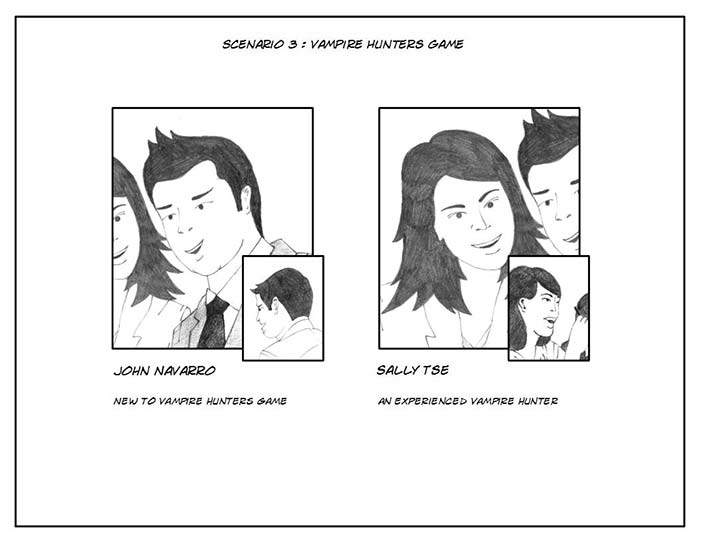 Courtesy of Mario Herger. Copyright: CC-Att-ND (Creative Commons Attribution-NoDerivs 3.0 Unported).
Courtesy of Mario Herger. Copyright: CC-Att-ND (Creative Commons Attribution-NoDerivs 3.0 Unported).
Figure 9.1: Vampire Hunter storyboard - the players.
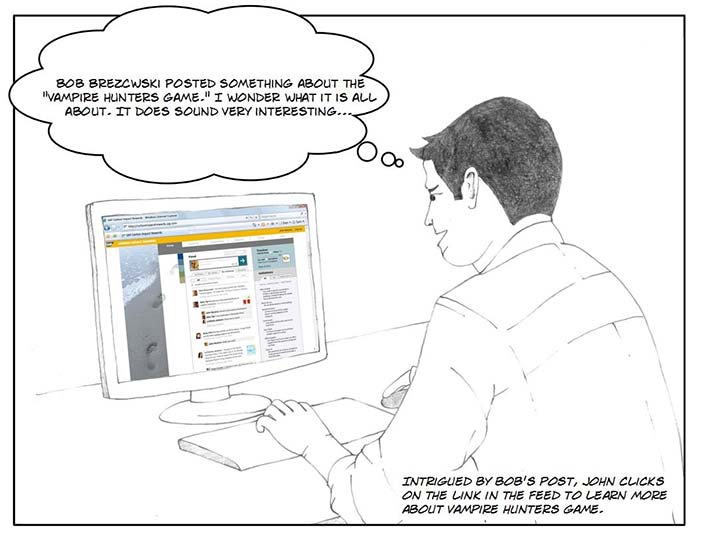 Courtesy of Mario Herger. Copyright: CC-Att-ND (Creative Commons Attribution-NoDerivs 3.0 Unported).
Courtesy of Mario Herger. Copyright: CC-Att-ND (Creative Commons Attribution-NoDerivs 3.0 Unported). Figure 9.2: Vampire Hunter storyboard - the initiative.
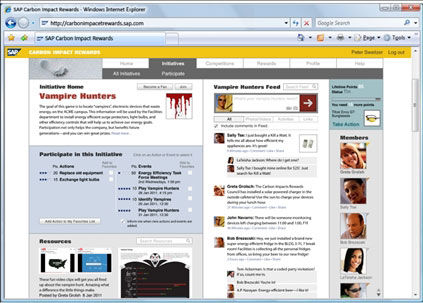
Figure 9.3: Vampire Hunter storyboard - the community.
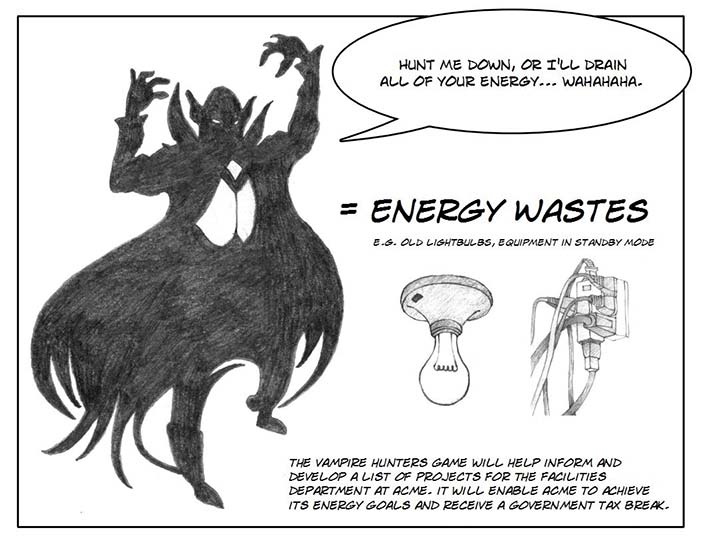 Courtesy of Mario Herger. Copyright: CC-Att-ND (Creative Commons Attribution-NoDerivs 3.0 Unported).
Courtesy of Mario Herger. Copyright: CC-Att-ND (Creative Commons Attribution-NoDerivs 3.0 Unported). Figure 9.4: Vampire Hunter storyboard - Vampires are energy suckers.
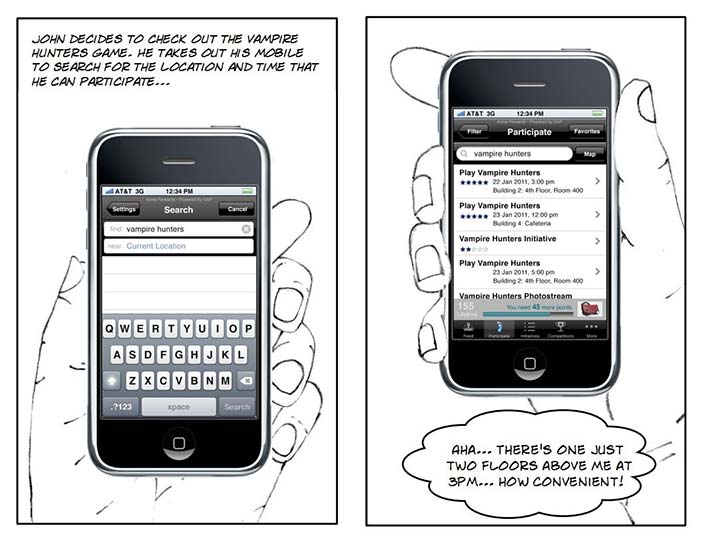 Courtesy of Mario Herger. Copyright: CC-Att-ND (Creative Commons Attribution-NoDerivs 3.0 Unported).
Courtesy of Mario Herger. Copyright: CC-Att-ND (Creative Commons Attribution-NoDerivs 3.0 Unported). Figure 9.5: Vampire Hunter storyboard - mobile interactions.
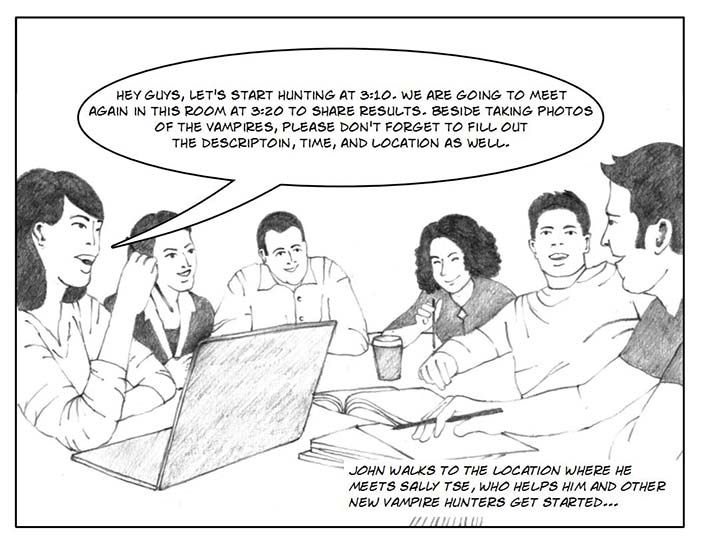 Courtesy of Mario Herger. Copyright: CC-Att-ND (Creative Commons Attribution-NoDerivs 3.0 Unported).
Courtesy of Mario Herger. Copyright: CC-Att-ND (Creative Commons Attribution-NoDerivs 3.0 Unported). Figure 9.6: Vampire Hunter storyboard - the real community and the virtual community.
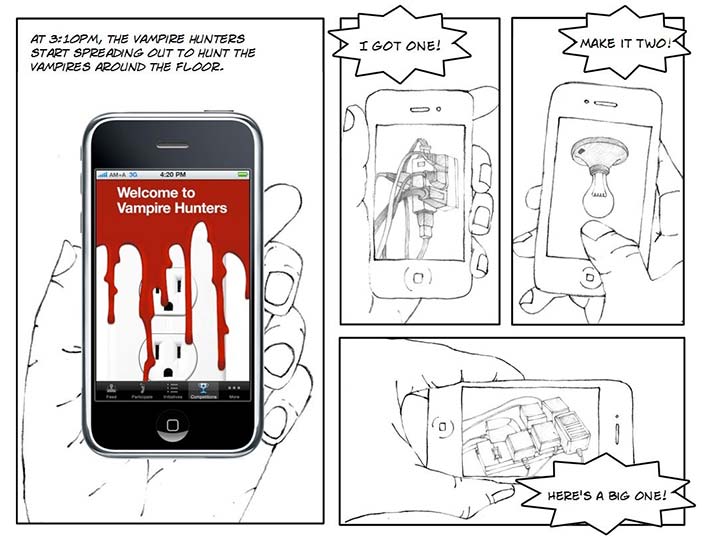 Courtesy of Mario Herger. Copyright: CC-Att-ND (Creative Commons Attribution-NoDerivs 3.0 Unported).
Courtesy of Mario Herger. Copyright: CC-Att-ND (Creative Commons Attribution-NoDerivs 3.0 Unported). Figure 9.7: Vampire Hunter storyboard - got one!
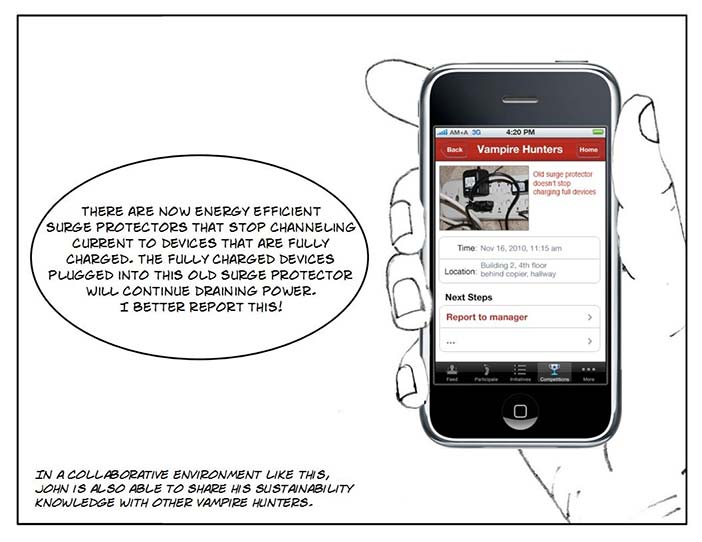 Courtesy of Mario Herger. Copyright: CC-Att-ND (Creative Commons Attribution-NoDerivs 3.0 Unported).
Courtesy of Mario Herger. Copyright: CC-Att-ND (Creative Commons Attribution-NoDerivs 3.0 Unported). Figure 9.8: Vampire Hunter storyboard - share knowledge with community.
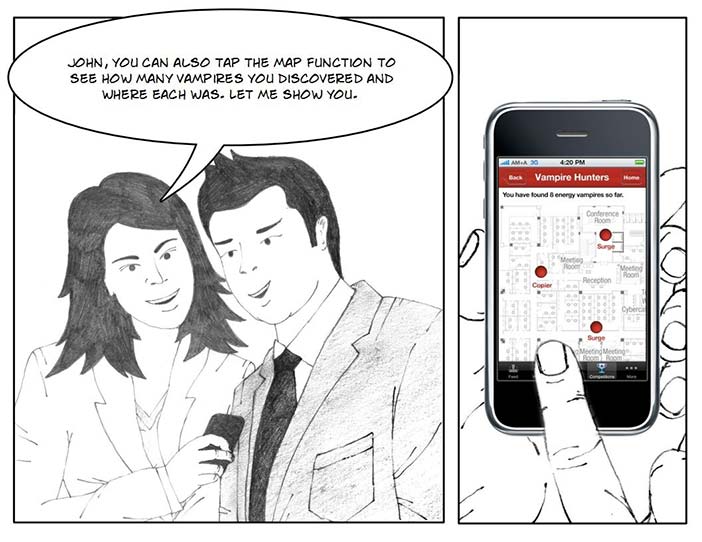 Courtesy of Mario Herger. Copyright: CC-Att-ND (Creative Commons Attribution-NoDerivs 3.0 Unported).
Courtesy of Mario Herger. Copyright: CC-Att-ND (Creative Commons Attribution-NoDerivs 3.0 Unported). Figure 9.9: Vampire Hunter storyboard - map view.
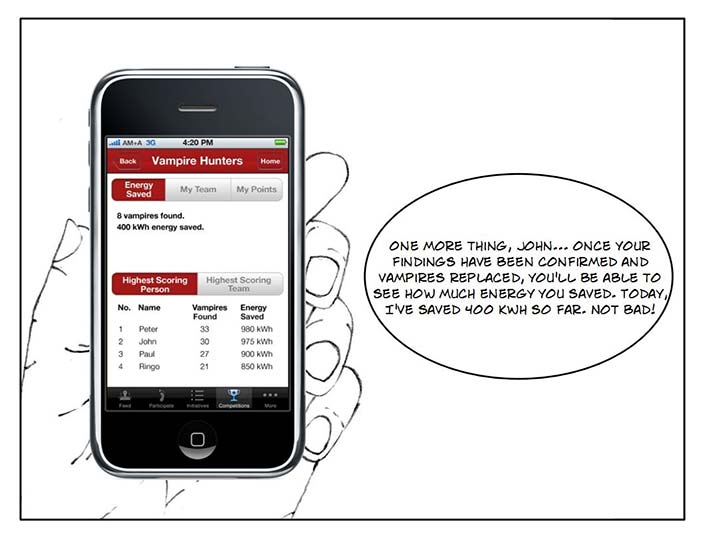 Courtesy of Mario Herger. Copyright: CC-Att-ND (Creative Commons Attribution-NoDerivs 3.0 Unported).
Courtesy of Mario Herger. Copyright: CC-Att-ND (Creative Commons Attribution-NoDerivs 3.0 Unported). Figure 9.10: Vampire Hunter storyboard - leaderboard.
Employees form teams and compete to identify "vampires" — or in more prosaic terms: "products that waste energy" — on the corporate campus.
They join the "vampire hunt" — a type of scavenger hunt — where colleagues walk through a certain area of a building to identify old light bulbs, equipment in standby mode, old surge protectors that keep charging devices even if they are fully charged, and other energy suckers. They take pictures with their smartphones and report that to the "vampire hunter headquarters." For each vampire found, a total of saved kWh is calculated and awarded to the members. The result leads not only to a reduction in energy consumption, lower costs and potential tax breaks, but also encourages previously unacquainted colleagues to network with one another.
9.2 SAP Roadwarrior
Being a sales representative in a large technology company like SAP involves keeping up with a constant stream of new technical information and dynamic changes. Sales representatives in emerging areas such as mobility technology have noted that they feel "sandwiched" between the inquiries and questions from customers and the flood of new technologies and mobile applications released by the development teams.
Typically, there are documents and e-learning videos available to the sales reps. However, these are time-consuming to go through, and sales reps do not find that this training format meets their needs.
Enter SAP Roadwarrior! SAP Roadwarrior is a game that simulates a customer meeting in which the sales rep needs to respond to customer questions to earn points and unlock badges. First, the sales rep is offered company information as part of a "pre-call planning". Then the sales reps are presented a series of customer questions. They can earn points and badges and unlock levels for correct question and meeting preparation. In the background, the system creates a "cheat sheet", for the sales rep, which the sales rep could use for real customer meetings. The game has features such as "life line" which allows the sales rep to learn throughout the game. It also offers instant feedback via a "conversation meter", to show how well the meeting is going.
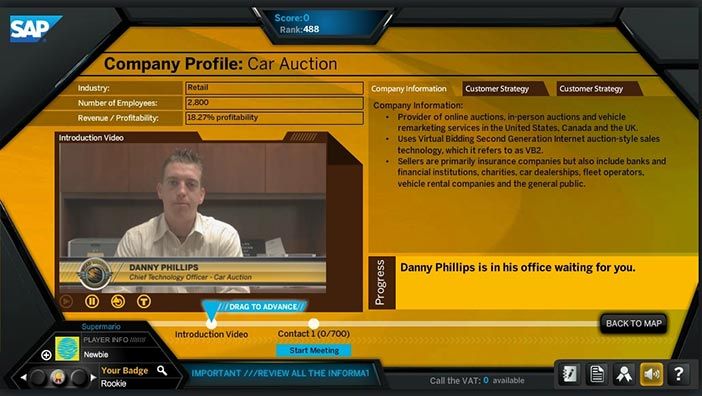 Copyright © SAP AG. All Rights Reserved. Used without permission under the Fair Use Doctrine. See the "Exceptions" section (and subsection "fairUse") of the copyright notice.
Copyright © SAP AG. All Rights Reserved. Used without permission under the Fair Use Doctrine. See the "Exceptions" section (and subsection "fairUse") of the copyright notice. Figure 9.11: SAP Roadwarrior screen showing the simulated sales negotiation with the CTO of a car auctioning company.
Sales reps meet with several customers in one industry before they can unlock the next level to meet customers from other industries. This allows sales reps to gather cross-industry knowledge. Players can also challenge other players, to match answers to a question. A leaderboard shows the score of all players. Being competitive in nature, this motivates the sales reps to try to do better than their peers do. Ultimately, it helps them feel more comfortable in customer meetings, having practiced via the simulations in Roadwarrior.
In the end, this game fulfills three purposes: it turns learning about SAP's mobile applications and technologies into a fun game, it puts sales reps into simulated meetings with customers to prepare them for real meetings, and it allows players to socialize, compete with and motivate each other. Of course, the real goal of the player is to sell more, make more money, and retire by 35 on an island in the Caribbean. "Another piña colada for the Beachwarrior, please!"
9.3 Time Recording
Recently, at the Gamification Summit in San Francisco, one of the authors (Herger) met Brady Wicken from the consulting company Slalom Consulting. He shared a gamified version of a time recording system that they had implemented in their organization.
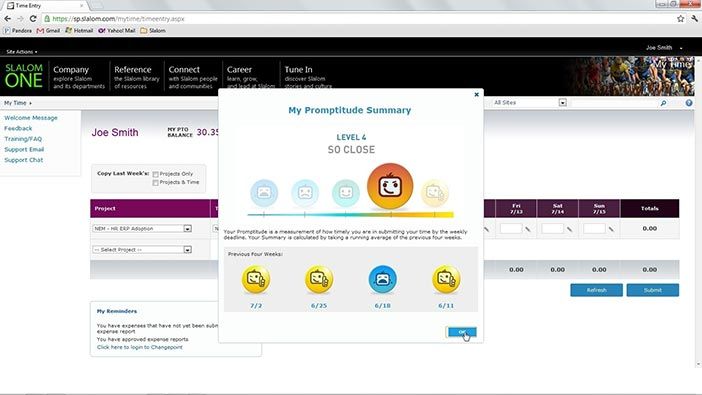 Copyright © Slalom Consulting. All Rights Reserved. Used without permission under the Fair Use Doctrine. See the "Exceptions" section (and subsection "fairUse") of the copyright notice.
Copyright © Slalom Consulting. All Rights Reserved. Used without permission under the Fair Use Doctrine. See the "Exceptions" section (and subsection "fairUse") of the copyright notice. Figure 9.12: Time Recording.
Slalom Consulting is a company that requires all their employees to assign their time correctly and promptly to the clients for accurate and on-time billing. The time must be entered by Sunday, approved by managers on Monday, clients billed and payroll run by Wednesday.
Any delay on the part of the employee delays the entire process downstream. To encourage employees to enter their time by Sunday, they created a "Promptitude" score. This is a simple score that evaluates if the employee entered their time by Sunday noon PST, and calculates a 4-week running average. This score is displayed on a scale of 1 — 5 with a sense of humor. The lowest score has some hilarious text that incorporates a healthy dose of friendly "Shamification". Introducing this simple widget was enough to remind the employees and motivate them to enter their information in time.
9.4 SmartGate — The Change Management Game
In 2009 Air Cargo Netherlands, Dutch Customs and Schiphol Airport decided to improve collaboration within the logistics chain to increase speed of deliveries. The logistics chain refers to the management of the flow of resources from its point of origin to its destination. It includes the process steps involved in both the flow of physical goods and the information flow in the system. To smoothen the airfreight system, they introduced a system called SmartGate (footnote 3) to have all parties in the logistics chain share relevant information in time. To educate employees from the parties involved, a game-version of SmartGate was developed that helped with the change management process to onboard people faster and make them feel more comfortable with the new system.
The objectives were to introduce SmartGate as a new way of working, to increase insight in 'chain-thinking' and show the consequences of transporting 'green' and 'red' freight. The target audience was 350 companies surrounding Schiphol Airport, involved in the air cargo industry as either a shipper, forwarder, trucker, handler, or airline.
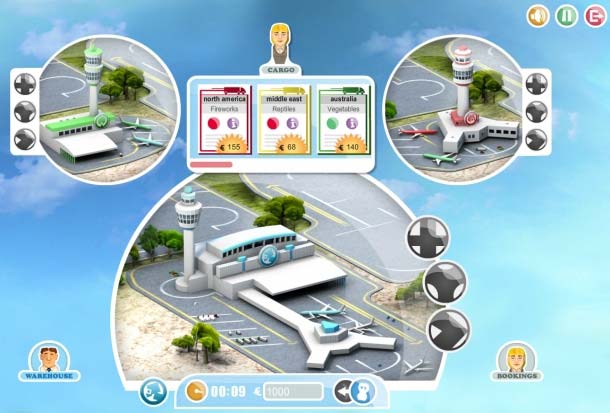
Copyright © Smart Gate The Game. All Rights Reserved. Used without permission under the Fair Use Doctrine. See the "Exceptions" section (and subsection "fairUse") of the copyright notice.
Figure 9.13: Smart Gate for change management and training.
9.5 Compliance Training
Employees of large corporations are required to complete mandatory compliance training annually. At SAP, we go through an online version of the Corporate Security and Business Code of conduct training. We are then tested on our knowledge and certified to be in compliance. Managers need to complete the Sexual Harassment (footnote 4) training periodically as well. Companies need to report externally the level to which their employees are trained and certified.
Most employees understand such compliance training's importance and business value, but find it boring and time consuming. As a result, a number of employees procrastinate and forget to complete the training. This leads to multiple reminders and managers being notified on non-compliance. This is all around a painful process for all parties concerned.
This is where TrueOffice comes in. The creative staff of TrueOffice have turned this boring compliance process round and gamified it. The players are normal office workers, and the mission is to train them and certify them in compliance. The designers have reimagined the dull compliance rules into fast-paced 20-minute interactive story modules. After each segment, the player is presented a compliance puzzle that they need to solve based on the training they just received. Players earn points and proceed through levels until completion.
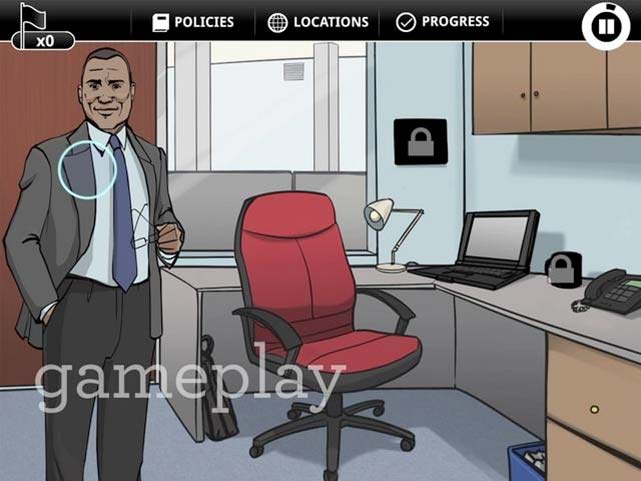
Copyright © True Office. All Rights Reserved. Used without permission under the Fair Use Doctrine. See the "Exceptions" section (and subsection "fairUse") of the copyright notice.
Figure 9.14: Interviewing characters during a TrueOffice compliance training
Managers can monitor their team's progress via a dash board. C-level executives can see their overall company's compliance status. TrueOffice is very popular in the banking industry as well as in other industries where a number of laws and regulations need strict compliance.
In January 2013, TruOffice raised $3.1 million in series A funding for gamified compliance training (footnote 5). True Office Founder and CEO, Adam Sodowick made the following comment with regard to his company's funding:
"With fines now exceeding the billion dollar mark for compliance oversights, financial institutions are looking to True Office to provide a solution that not only protects their business and reduces costs, but also exponentially raises the current industry standard for compliance training. There aren't many effective options to help understand regulation and change behaviors but a well-designed game has the power to engage employees and at the same time, produce analytics that can help the banks identify and reduce operational and compliance risk."
9.6 More examples
More gamification examples in the enterprise context can be found under http://enterprise-gamification.com/index.php/en/examples.

